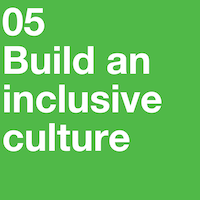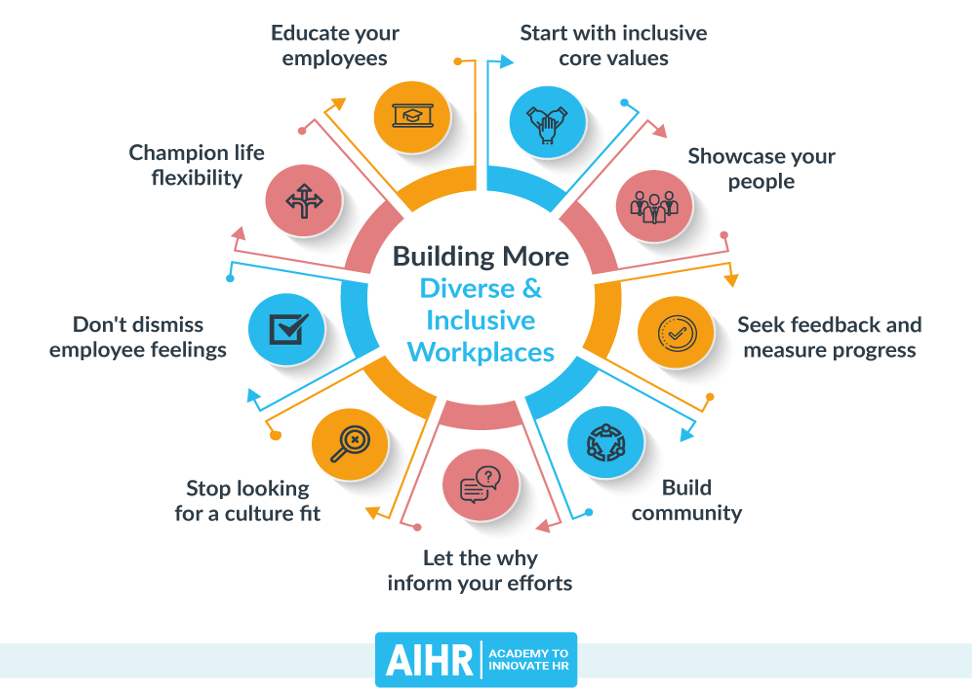Main Content

Diversity, Equity & Inclusion: 05 Resources for building an inclusive culture
To embark on the Diversity, Equity and Inclusion (DE&I) journey you will need to create resources for your team. Policies and guidance can help educate and remove unconscious bias.
 You will find a snapshot of policies and guidance below, which can help on your DE&I journey.
You will find a snapshot of policies and guidance below, which can help on your DE&I journey.
However, the approach taken by each company will be unique.
While a number of free tools and sample policies exist, it is important to create your own policies which reflect the size and type of company you are.
It is also worth considering partnering with an expert who has deep knowledge and experience of DE&I.
What’s covered below
- Inclusive hiring
- Creating an inclusive culture
- Policies
- Further reading and resources.
Every business is different. These pages are a guide to key principles and best practice and can signpost you towards types of resources that could help you, but they are no substitute for working with an experienced, expert specialist who can fully understand your business and offer tailored advice.
Inclusive hiring
None of us is immune from unconscious bias, but recruitment processes can be designed to reduce the influence of bias and discrimination. The Chartered Institute of Personnel and Development (CIPD) offers a guide to inclusive recruitment. Focusing on the stages of recruitment, the key recommendations in CIPD’s guide include:
1. Role design and job advert
Person requirements
- Make role requirements clear, specific and behaviour-based.
- Remove biased language from job adverts.
- Caution: avoid mandating diversity statements.
- Caution: avoid a requirement for ‘cultural fit’ or ‘person-organistion fit.’
Job specification
- Offer flexible working by default.
- Make salaries non-negotiable and include them in job adverts.
- Advertise the specific benefits and policies available.
2. Attracting diverse candidates
Target marginalised groups to apply
- Place job adverts where they are more likely to be seen by marginalised applicants.
- Use targeted ‘word of mouth’ referrals.
- Focus outreach efforts on marginalised groups.
Making the recruitment experience inclusive
- Provide candidates with clear expectations, timelines and communications.
- Proactively ask applicants if they need reasonable adjustments during the recruitment process.
3. Application process
- Anonymise applications.
- Caution: avoid asking candidates about the dates of their employment history.
4. Selection process
Sifting candidates
- Reduce bias in automated sifting.
- Include more marginalised candidates in the shortlist.
- Caution: avoid using social media to sift applicants.
Interviews and assessments
- Make scheduling interviews easy, accessible and flexible.
- Use structured interviews.
- Use skill-based assessment tasks in recruitment.
Evaluate candidates
- Make decisions about candidates in batches.
- Use calibrations for hiring decisions.
- Caution: avoid mandating diverse interview panels.
Post-offer
- Share and collect feedback from and to all candidates.
- Proactively offer reasonable adjustments to all new joiners.
- Encourage candidates to reapply.
5. Monitoring and measuring
- Set diversity targets for recruitment.
- Collect high-quality data to monitor inclusion outcomes.
- Analyse recruitment data to prioritise inclusion efforts.
CIPD’s full guide for employers to ensure fair processes are set up to attract a more diverse talent pool, can be found here.
Creating an inclusive culture
Hiring diverse candidates is only the start of the journey; those people will not want to stay in your business unless there is a culture where they feel welcome, and that their perspective is valued. You may benefit from making reasonable adjustments to accommodate candidates who may otherwise not fit your current working pattern or culture. Psychological safety is critical for people to perform at their best. The Academy to Innovate HR describes nine steps for creating a more inclusive culture [1]:

Naturally, building an inclusive culture isn’t an overnight fix, nor is this nine-step process simple to implement overnight. You need to create space in your business and leadership priorities to work through this with a cross-functional team. Some things to consider:
Audit current culture and sentiment
It’s hard as someone in management to be a true barometer of culture, and especially in this context if you are not from a diverse background yourself. It is only with lived experience that you can understand motivators of feelings and behaviours. Gaining insight into the culture from the eyes of your team and potentially an impartial DE&I advisor is invaluable if you are committed to making a change. Consider if this can be done adequately using in-house resource and simple tools such as employee surveys, or if an outside party or paid-for sentiment software is needed for your business. Be prepared to ask hard questions and don’t presuppose the answers.
Create a realistic change/implementation plan
Armed with the insight from your audit, set out a realistic timeline and change plan, knowing that true cultural change requires time, resource, training and commitment. It is unlikely that small changes will be the answer to supporting and developing colleagues from diverse backgrounds. You may discover in your audit that your working practices are impacting your inclusion efforts, for example, or that a culture that centres on overworking, alcohol or other ‘norms’ can take time and can be a barrier. Hard conversations are needed at a senior level about your appetite for and willingness to change.
Establish an appropriate governance structure
How will you hold yourselves to account on creating an inclusive culture? Consider if your existing governance structure (Boards, management forums, management information, etc) supports this critical objective. Ask also: how will you measure success beyond diversity statistics? Put in place the processes needed to capture information, whether that’s regular surveys, new employee feedback mechanisms, employee groups/forums, etc.
Take communication seriously
Internal communication starts with ensuring everyone understands the purpose, vision and values of the company. If DE&I is to be taken seriously it needs to become embedded in the core values of the business and communicated consistently and regularly.
Policies: an overview
Policies which may help you create an inclusive culture include[2]:
- Equal opportunities
- Recruitment and selection
- Flexible working
- Code of conduct
- Dignity at work (including bullying, harassment & discrimination policy)
- Parental/adoption leave
- Disability & reasonable adjustments
- Religious and cultural holidays & dress
- Neurodiversity, mental health, wellbeing & menopause
- Trans inclusion
- Speaking up
Each of these policies should ideally include and consider:
- A declaration of your commitment to your employees in this area
- A commitment to periodic reviews and updates, with employee input
- Leadership commitment and transparency
- The responsibilities of management, employees, and other stakeholders in upholding, measuring, reporting and promoting each policy within your organisation and when orienting new hires
- Any training and support systems that you have in place to support the policy
- Accessibility to the policy, including for those with disabilities or language barriers
Ensure you:
- Use non-gendered language
- Check current statutory rights and legal obligations
- Run your policies by a trained HR professional
Policies: a closer look
Equal opportunities
An equal opportunities policy should declare your commitment to equality, including the prohibition of discrimination based on protected characteristics (as defined by the Equality Act 2010).
Emphasise equal and fair access to hiring, learning & development, mentorship, promotion and salary reviews.
Be transparent on how you intend to ensure this equal and fair access for all.
Recruitment and selection
See Inclusive Hiring.
Flexible working
A flexible working policy can help eliminate barriers that could disproportionately affect underrepresented groups, such as:
- Parents and pregnant workers
- People with disabilities (physical or neurological)
- Caregivers
- Students
- Those with lower incomes who might benefit from travelling outside of peak hours
- Those with a long commute, whether by choice or circumstance
- Menstruating and menopausal employees
- Mature staff
- Those pursuing personal goals
- Cultural and religious accommodations
- Emergency situations
- Compassionate leave
Consider how your flexible working policy might work in each of these cases and declare your commitment to accommodating diverse needs and circumstances, promoting work-life balance, reducing stress and improving well-being.
Eligible employees have the legal right to submit a formal request for long-term flexible working.
Outline:
- The formal application process
- Timings for consideration of the request
- On what grounds a request may be declined and how this will be communicated
- Trial period
- The appeals process
Code of conduct
This establishes expectations, provides a moral compass for your employees, promotes a positive culture and protects your reputation.
Consider the following:
- Reflect your company values and culture
- Use clear language to define behaviours and expectations around:
- Respect
- Diversity
- Ethical standards
- Confidentiality
- Use of company resources including equipment, time and information
- How to communicate/report violations
- Consequences of violations
- Conflict resolution processes
Dignity at work (including bullying, harassment & discrimination policy)
Declare your commitment to providing a working environment that respects the rights of each employee and where colleagues treat each other with respect. Emphasise that any behaviour which undermines this is unacceptable, and that you do not tolerate any form of harassment, bullying or discrimination under any circumstances.
List and explain your definitions of harassment, considering:
- Verbal
- Non-verbal
- Physical
- Coercion
- Isolation and exclusion
- Intrusion
Be clear about:
- Your definitions of workplace bullying (obvious and not so obvious) and discrimination
- How to communicate/report violations
- Consequences of violations
- Conflict resolution processes
Parental/adoption leave
Declare your commitment to a progressive, inclusive and gender-neutral approach to your parental leave policy.
- Direct employees to the latest government website explaining their statutory rights (and give a simple overview in your policy)
- Define Primary and Secondary caregivers
- Research your competitors and decide if you want/are able to offer your employees an enhanced package
- Consider Shared Parental Leave
- Be clear on how much notice is required before taking any form of parental leave (traditional/surrogacy/adoption)
- Include a statement about paid time off for antenatal, adoption and fertility appointments
- Miscarriage and compassionate leave – check statutory rights and confirm if you will offer more than this
- Returning to work:
- How much notice is required if your employee intends to return to work earlier than planned
- Agreement of return date
- Encourage a phased return to work
- Keep in Touch days
- Updates on client progress/changes
- Breastfeeding policy – check statutory rights and confirm if you will offer more than this
- Planning for the unexpected (children get sick)
- Other sources of support (internal, external, help with childcare costs etc)
Disability & reasonable adjustments
Declare your commitment to ensuring that employees with disabilities are treated fairly, that their needs are met, and that they can fully participate in the workplace without discrimination.
A typical policy would include:
- A clear definition of what constitutes a disability (physically or neurologically)
- A reiteration of your commitment to Equal Opportunities (and/or a reference to that policy)
- Details on how you will identify and implement reasonable adjustments or accommodations to support employees with disabilities
- Information on how to request these accommodations
- The process for assessing requests and the steps and timings within with to implement them
- Clarity over confidentiality of disability-related information and who has access to it
- A commitment to training employees and managers on awareness, anti-discrimination, and the adjustments and accommodations necessary
- Who to contact internally or externally for support
Religious and cultural holidays & dress
Declare your commitment to an inclusive and respectful work environment where employees of various religious and cultural backgrounds can comfortably practice their beliefs and express their identity through attire.
A typical policy would include:
- A recognition that your employees have a right to observe religious and cultural holidays
- How employees can request time off for these events, including paid and unpaid leave options
- Guidelines regarding appropriate dress in the workplace, emphasising the importance of respecting individual choices and accommodating religious dress requirements within reason
- A commitment to reasonable accommodations for employees’ religious practices, as long as it doesn’t pose an undue hardship on the business
- A strong statement affirming that you will not tolerate discrimination or harassment based on an individual’s religious beliefs, cultural background or attire.
Neurodiversity, mental health, wellbeing & menopause
Neurodiversity refers to the different ways the brain can work and interpret information. Each person is unique and there can be a high degree of overlap between neurodivergent conditions. It is estimated that up to 1 in 7 people have some kind of neuro difference. The most common types of neurodiversity are Autism or Autism Spectrum Conditions, ADHD (Attention Deficit Hyperactivity Disorder) or ADD (Attention Deficit Disorder), Dyscalculia, Dyslexia, Dyspraxia or Development Coordination Disorder (DCD). Many of these differences are associated with increased creative abilities.
A helpful guide to Neurodiversity at work is published by the Chartered Institute of Personnel Development.
Croner explores how to support neurodiverse employees at work and legal rights to reasonable adjustments. Examples of which include, but are not limited to: reducing sensory stimulus, offering flexible working arrangements, requesting a static workstation, allowing input into the design of their workplace or workstation, allocating work areas with more natural light, taking extra breaks at short notice, providing a mentor/buddy when learning new tasks, amongst others.
A Neurodiversity policy should include:
- What is Neurodiversity (definitions)
- The legal framework (Equality Act 2010)
- Principles we will follow
- Support for Neurodiverse identification/diagnosis
- How we will support our employees
- Definition of reasonable adjustments
- Futher support that will be offered.
Trans inclusion
Declare your commitment to fostering an inclusive and welcoming environment where transgender employees, clients and stakeholders are treated fairly and with dignity.
A typical policy would include:
- A clear definition of transgender individuals and an explanation of how the policy applies to all aspects of the organisation including employment, facilities, services and interactions
- A strong statement affirming that you will not tolerate discrimination or harassment on the basis of gender identity or gender expression
- Emphasis on the importance of treating all individuals, regardless of gender identity or gender expression, with respect, dignity and courtesy
- Guidelines for respecting an individual’s preferred names and pronouns
- Policies regarding access to gender-segregated facilities that respect an individual’s gender identity
- Clarity over confidentiality of gender-related information and who has access to it
- A commitment to training employees and managers on awareness, anti-discrimination, and the adjustments and accommodations necessary
- Who to contact internally or externally for support.
Speaking up
A speak up policy encourages employees to speak about issues when they arise, to be inclusive and to encourage resolution through discussion wherever possible. It will include provision for how to raise issues further if initial inclusive conversations are not felt to have resolved an issue.
The NHS published a National Freedom to Speak Up Policy.
A speak up policy could include:
- Vision statement – why people should speak up, the culture we seek to create
- What can I speak up about?
- Creating a culture of safety about speaking up
- Who can I speak to?
- Speaking up if I feel my issue has not been resolved
- Advice and support
- What will we do?
- What to do if I feel I need to make a protected disclosure.
Further resources and reading
Gender decoder
Unconscious bias can result in job adverts and role profiles that are encode bias. The use of a gender decoder to check text can help. This site is a quick way to check whether a job advert has subtle linguistic gender-coding.
Gender and Sexuality: read a guide to basic terminology here.
Wider reading
A useful example of Diversity, Equity and Inclusion definitions as used by the Independent Sector, a non-profit organisation focused on ensuring all people thrive.
Positive action in the workplace: government guidance for employers who want to use positive action to widen opportunities in a way that is consistent with equalities legislation.
Recognise the link between employee engagement and DE&I: HR Exchange Network article.
It’s (past) time to get strategic about DE&I: McKinsey & Company article.
How to produce communications that include, accurately portray, and are accessible to disabled people: access government guidance on inclusive communication.
This guide was produced by the DBA’s Diversity, Equity & Inclusion Council – a group of experienced individuals drawn from across the DBA membership, working to strengthen DE&I in the design industry to create a diverse community whose instinct is to design for all. Through a commitment to DE&I and inclusive design, we can all contribute to a more welcoming, responsive and accommodating world.
Every business is different. These pages are a guide to key principles and best practice. They are designed to signpost you towards the types of resources that could help your business on its DE&I journey, but they are no substitute for working with an experienced, expert specialist who can fully understand your business and offer tailored advice.
These guides do not constitute legal advice and the DBA signposts to sources of other advice and information as a guide only.